The mobile pellet harvester and stationary mill: In presenting the Premos 5000 (Kalverkamp system), KRONE is once again making a powerful statement of its innovative performance: The Premos is at the same time mobile pellet harvester and a stationary pellet mill that harnesses the huge potential of straw, which is abundantly available in the fields around the world, and presses it into top-quality, high-fibre pellets. These make ideal bedding, animal feed and fuel.
Product video
KRONE Premos 5000
In presenting the Premos 5000 (Kalverkamp system), KRONE is once again making a powerful statement of its innovative performance: The Premos is at the same time a mobile pellet harvester and a stationary pellet mill that harnesses the huge potential of straw, which is abundantly available in the fields around the world, and presses it into top-quality, high-fibre pellets. These make ideal bedding, animal feed and fuel.
Product features
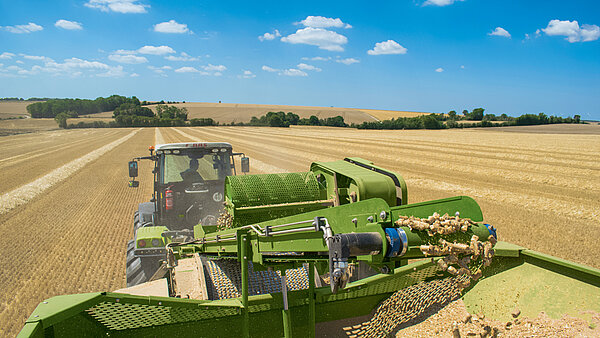
In presenting the Premos 5000 (Kalverkamp system), KRONE is once again making a powerful statement of its innovative performance: The Premos is at the same time a mobile pellet harvester and a stationary pelleting press which harnesses the huge potential of straw and other crop stalks which are abundantly available in the fields around the world, and presses it into top-quality, structural pellets. These make ideal bedding, animal feed and fuel.

The pellets are conveyed to the 9 m³ hopper. Here they are cooled by a blower after they were heated under the high pelleting pressure. As soon as the hopper, which also features a weighing system, is filled to capacity the pellets can be unloaded into a chaser bin.

Augers inside the die rollers feed the pellets to an elevator which in turn feeds them through a sieving drum. Here, dust and debris are separated from the pellets and returned to the pellet press rollers. The results are pellets of an optimum quality that are suitable for use as bedding, feed or fuel.
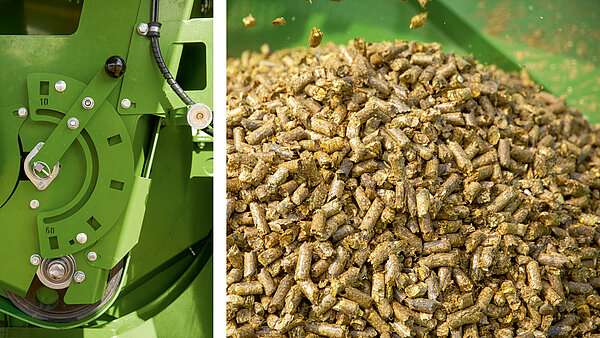
As the material flows between the two die rollers it is pressed into the 16 mm holes and from here into the inside of the rollers. The pellet diameter is fixed as it is determined by the diameter of the holes, but pellet length varies between 15 mm and 40 mm by adjusting the gap between the spacers and the pellet press roller.

The material is milled by two counter-rotating and interlocking pellet press rollers with alternating rows of teeth and holes. The teeth of one roller mesh with the holes of the other, pressing the material into the holes and depending on the crop, pressures of up to 2000 bar and temperatures of up to 100°C are generated.

- Production of marketable structural pellets directly in the field
- Up to 5,000 kg throughputs per hour
- Water and oil dispenser for optimum results
- On-board cooling keeps pellet quality high
The Premos 5000 is the first pelleting press which picks up stalk crops such as straw, hay or lucerne directly inthe field and compresses them into structural pellets. The finished product is then overloaded into a chaser bin.

Temperatures of up to 100 °C are generated during pelleting. To avoid the pellet quality deteriorates during storage, the pellets are cooled by a fan that blows air into the hopper through a double floor.
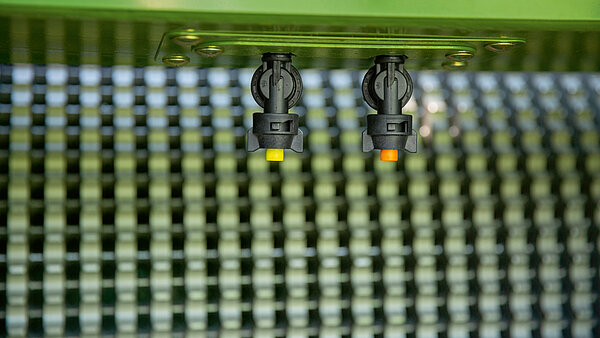
A dispenser meters water or oil to a bank of jets that spray the liquid on the pellet press rollers. This feature optimizes the moisture levels and adhesion properties of the material, which is the basis for a consistently high quality.

An 800 mm wide rotor feeds the material to the feeding belt. Foreign objects drop into a stone trap that is arranged behind the rotor while the material is conveyed to the die rollers.
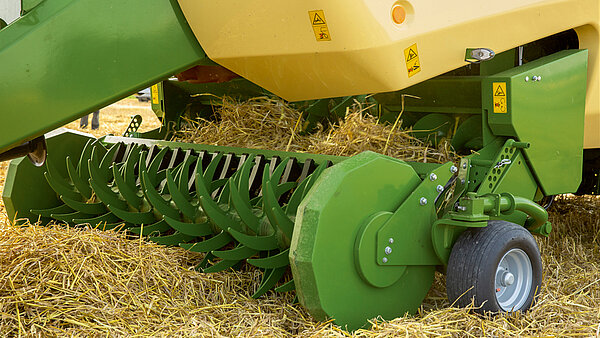
The 2.35 m wide and camless pick-up gathers the crop and a retaining roller ahead of the pick-up ensures a very uniform flow also at low forward speeds.

- The first mobile pellet press that also operates as a stationary pellet mill
- Bale shredder, integral feed table, automatic twine removal
- Fold-up feed table for convenient changeover into transport position
When used as a stationary pelleting press, the Premos can pelletise stalk-type crops all year round. The bale is removed from storage and fed into the machine via a system of shredding rollers. To convert Premos into a stationary mill, remove the pick-up and replace this by the bale shredder which makes an integral part of the machine.

To changeover into transport position, the feed table folds hydraulically up on the side of the machine for easy road transport and a transport width of less than 3 m – for fast and easy moves between sites.

This unit consists of four hydraulic rotors that have blades and guide plates. As the bale passes over them, the straw is cut by the blades and pulled out by the serrated plates. Additional deflector sheets are arranged behind the rollers to ensure an optimum distribution of the material across the working width.

The twine is removed automatically at the end of the table. while a triangular blade cuts the threads at the bottom. A bundling hook above the bale pulls the twine towards a rotating spool which winds up the threads using catch mandrels and then removes them from the bale.
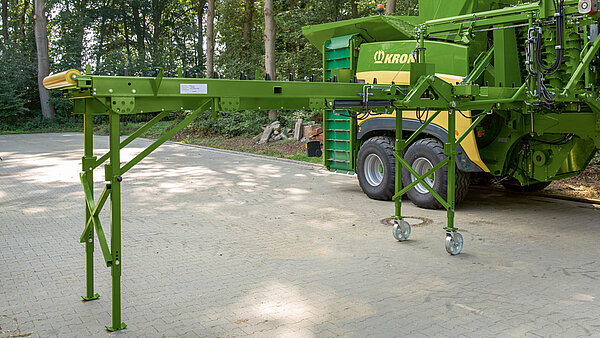
The stationary Premos has a 7.5 m long feed table with a hydraulic folding mechanism. After the bale is placed on the table, it is fed by two chains with lugs to the shredding rotors.

- Straw pellets with high bulk density of up to 700 kg/m³ (density greatly dependent on crop)
- Excellent absorption qualities for ideal bedding
- Adds structure to the ration
- Excellent toys for pigs
- Enormous potential as a renewable energy source
- High gas yield in the biogas plant due to digestion of the straw during pelleting
The KRONE Premos 5000 produces structural pellets which differ significantly from DIN pellets in terms of their composition. With a diameter of 16 mm, the structural pellets produces from unchopped crops are considerably larger. Rich in fibre, pellets add structure to the ration and offer good absorption qualities as bedding. The structural pellets also show their astrengths in the biogas plant. No floating layers and digestion during the pelleting process ensure a significantly higher gas yield and a smooth-running plant.

A sustainable fuel: 2.5 kg straw pellets substitute for 1 l fuel oil. On a global scale, about 800 million tonnes of straw are available for use as fuel. The annual amount of straw harvested in Germany is 30 million tonnes, of which 8-13 million tonnes can be used as a renewable energy resource. Straw therefore offers a huge, so far only partially exploited, potential to make a significant contribution to climate protection as a "renewable fuel" by reucing CO2.
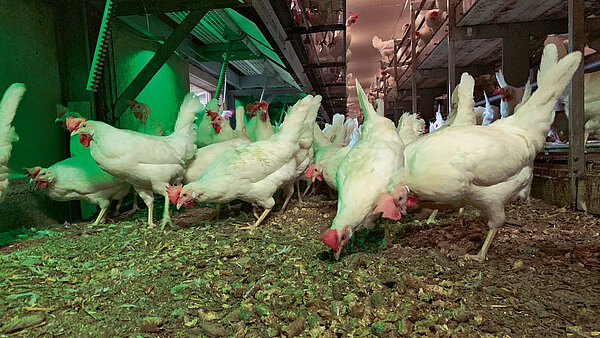
Better animal Hygiene: The high absorbency of straw pellets also pays off in poultry farming: As the floor is less smeared with bedding conteining structural pellets, not only the feet of the laying hens remain clean, but also the nests and the eggs in them. In addition, it reduces ammonium pollution in hen houses.

Ideal for horses: Offering high liquid-absorbing capacities, straw pellets keep horse boxes dry. The disinfectant qualities can help control pathogens which account for typical fungal infections such as thrush or grapes. One further boon is that, because they contain very little dust, straw pellets reduce the risk of horses contracting breathing difficulties

Comfortable bedding for cattle: 1 kg of structural pellets can absorb up to 4 l of water. This high liquid absorbing capacity makes straw pellets the ideal bedding for housed cows. The cleaner environment leads to cleaner cows and better udder and animal health. In addition, less bedding is required when pellets are used instead of straw chops.

Structural pellets are largely dust-free and sterile and can be used, for example, in small quantities in pig husbandry as an occupational material. As such, structural pellets encourage the animals' natural exploratory behaviour and are ideal for the "Animal Welfare Initative".

Feeding pellets to animals: Pellets from hay, lucerne and straw make excellent base rations. Research show that the structural pellets have significantly traces of pathogens and mould compared to straw from bales. This is proof of their high quality for use as animal feed.

- Easy use and easy operation via terminal
- DS 500 – Standard operator terminal with 5.7" colour display
- CCI 800 – User-friendly operating terminal with 8" touch display
- CCI 1200 – User-friendy operating terminal with 12" touch display
Premos is conveniently operated from a number of easy-use operator terminals. From here, operators check machine functions and enter settings.

The DS 500 with its 5.7" colour display is the standard operating terminal for the Premos 5000. It off ers twelve function keys and a touch screen for easy and straightforward machine control.

The CCI 800 or the 1200 terminal with 8" or 12" touch display is ideal for operating the Premos 5000. The home screen shows the current level of machine utilization, the pellet density, temperature and moisture level. Tap the buttons to retrieve the menu items and access machine data and settings.
Models
| Premos 5000 | ||
|---|---|---|
| Types of crops | Hay, alfalfa, straw with less than 16% residual moisture |
configure
|
| Machine dimensions (m, L x W x H) | 8.90 x 2.99 x 3.80 |
configure
|
| Pick-up working width (m) | 2.35 |
configure
|
| Pellet diameter (mm) | 16 |
configure
|
| Throughput (t/h) | bis 5 |
configure
|
| Hopper capacity (t) | 5 |
configure
|
| Input power (kW/hp) | 257 / 350 |
configure
|
|
configure
|
![[Translate to EN:] [Translate to EN:]](/fileadmin/_processed_/7/5/csm_EasyCut_Freisteller_468x468px_14_c46259e600.png)
![[Translate to EN:] [Translate to EN:]](/fileadmin/_processed_/9/f/csm_ActiveMow_KRONE_Freisteller_468x468px_90896875ef.png)
![[Translate to EN:] [Translate to EN:]](/fileadmin/_processed_/7/5/csm_EasyCut_R_468x468px_57ba0a365d.png)
![[Translate to EN:] [Translate to EN:]](/fileadmin/_processed_/4/c/csm_EasyCutTS_TC_Freisteller-02_468x468px17_e254895969.png)
![[Translate to EN:] [Translate to EN:]](/fileadmin/_processed_/5/1/csm_EasyCutB_Freisteller_468x468px13_dcaf1d42a4.png)
![[Translate to EN:] [Translate to EN:]](/fileadmin/_processed_/4/b/csm_EasyCut_F_Highland_468x468px_13a01ebe6c.png)
![[Translate to EN:] [Translate to EN:]](/fileadmin/_processed_/3/d/csm_Vendro_Freisteller_468x468px34_cae6bbd02e.png)
![[Translate to EN:] [Translate to EN:]](/fileadmin/_processed_/0/3/csm_Freisteller_KWT_468x468px_aec722e4d8.png)
![[Translate to EN:] [Translate to EN:]](/fileadmin/_processed_/8/c/csm_Freisteller_Highland_Vendro_468x468px_3d3deddc5c.png)
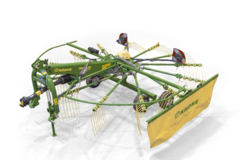

![[Translate to EN:] [Translate to EN:]](/fileadmin/_processed_/e/0/csm_Freisteller_Highland_Swadro_468x468px_e4de84fa0f.png)
![[Translate to EN:] [Translate to EN:]](/fileadmin/_processed_/0/4/csm_Bellima_KRONE_Freisteller_468x468px3_1b2baf5141.png)
![[Translate to EN:] [Translate to EN:]](/fileadmin/_processed_/6/f/csm_Fortima_Freisteller_468x468px20_62bb2513c4.png)
![[Translate to EN:] [Translate to EN:]](/fileadmin/_processed_/0/1/csm_Comprima_Freisteller_468x468px11_f9daee659a.png)
![[Translate to EN:] [Translate to EN:]](/fileadmin/_processed_/7/2/csm_Comprima_Plus_Freisteller_468x468px12_3fc2796f9a.png)
![[Translate to EN:]](/fileadmin/_processed_/6/d/csm_ComPack_AK17649_275143_468_fc3b57f496.png)
![[Translate to EN:] [Translate to EN:]](/fileadmin/_processed_/9/a/csm_CombiPACK__AK_270094_468px_e8c97eae1e.png)
![[Translate to EN:]](/fileadmin/_processed_/1/c/csm_VariPack_Freisteller_01_a70a02f9f9.png)
![[Translate to EN:]](/fileadmin/_processed_/c/2/csm_VariPackPlus_Freisteller_468x468px33_142df8329b.png)
![[Translate to EN:]](/fileadmin/_processed_/f/1/csm_VariPack_Pro__AK_269063_468px_23b96ff27c.png)
![[Translate to EN:] [Translate to EN:]](/fileadmin/_processed_/9/d/csm_EasyWrap150_Freisteller_468x468px18_ee82a0e7eb.png)
![[Translate to EN:] [Translate to EN:]](/fileadmin/_processed_/1/2/csm_EasyWrap165T_Freistellern_468x468px19_34801004fa.png)
![[Translate to EN:] [Translate to EN:]](/fileadmin/_processed_/7/0/csm_BiGPack_KRONE_Freisteller_468x468px_0850ee1d84.png)
![[Translate to EN:] [Translate to EN:]](/fileadmin/_processed_/e/0/csm_BiGPack_5-Generation_Freisteller_468x468px8_a813ec6a9f.png)
![[Translate to EN:] [Translate to EN:]](/fileadmin/_processed_/9/8/csm_BiGPack_AK10841_280880_468px_116a7e307b.png)
![[Translate to EN:] [Translate to EN:]](/fileadmin/_processed_/0/b/csm_Bale_Collect_468x468px_eaea52b993.png)
![[Translate to EN:] [Translate to EN:]](/fileadmin/_processed_/5/7/csm_Premos5000-Freisteller_468x468px27_86749ba5d4.png)
![[Translate to EN:] [Translate to EN:]](/fileadmin/_processed_/9/0/csm_KRONE_Freisteller_mit-schatten_468x468px2_bf6d5d115c.png)
![[Translate to EN:] [Translate to EN:]](/fileadmin/_processed_/f/c/csm_MX_Freisteller_468x468px26_6be6e9aee6.png)
![[Translate to EN:] [Translate to EN:]](/fileadmin/_processed_/4/f/csm_RX_Freisteller_468x468px_6ecb398329.png)
![[Translate to EN:] [Translate to EN:]](/fileadmin/_processed_/0/a/csm_ZX_Freisteller_468x468px_cc1e39f93f.png)
![[Translate to EN:] [Translate to EN:]](/fileadmin/_processed_/4/f/csm_TX_Freisteller_468x468px_49a9760536.png)
![[Translate to EN:] [Translate to EN:]](/fileadmin/_processed_/0/3/csm_GX_Freisteller_468x468px21_24b0cbfe61.png)




![[Translate to EN:] [Translate to EN:]](/fileadmin/_processed_/5/7/csm_BiGM_KRONE_Freisteller_468x468px4_a92e7475bc.png)
![[Translate to EN:] [Translate to EN:]](/fileadmin/_processed_/4/7/csm_BiGX480_Freisteller_468x468px9_1017c2fa62.png)
![[Translate to EN:] [Translate to EN:]](/fileadmin/_processed_/c/5/csm_BiGX680_Freisteller_468x468px10_c77559da75.png)





